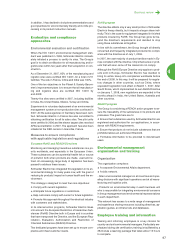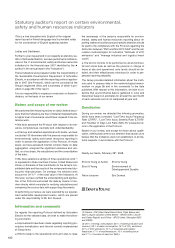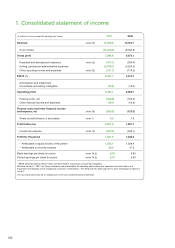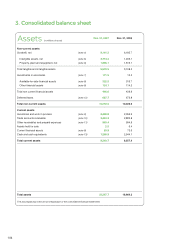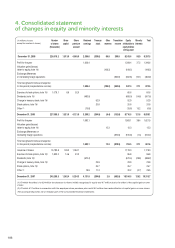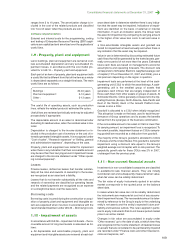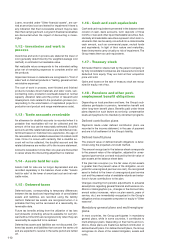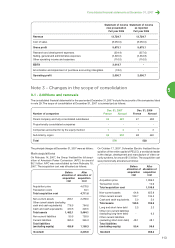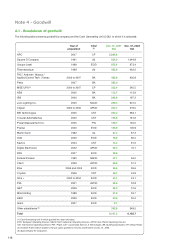APC 2007 Annual Report Download - page 109
Download and view the complete annual report
Please find page 109 of the 2007 APC annual report below. You can navigate through the pages in the report by either clicking on the pages listed below, or by using the keyword search tool below to find specific information within the annual report.
5
Consolidated financial statements at December 31, 2007
5. Notes to the
consolidated financial
statements
All amounts in millions of euros unless otherwise
indicated.
The accompanying notes are an integral part of the
consolidated financial statements.
The consolidated financial statements for the year ended
December 31, 2007 were approved by the Management
Board of Schneider Electric on February 15, 2008 and re-
viewed by the Supervisory Board on February 19, 2008.
They will be submitted to shareholders for approval at the
Annual General Meeting of April 21, 2008.
The Group’s main businesses are described in Chapter 1
of the Annual Report.
Note 1 - Summary of
significant accounting policies
1.1 - Accounting standards
Schneider Electric’s consolidated financial statements
have been prepared in compliance with IASB standards
applicable as of December 31, 2007 and the international
accounting standards adopted by the European Union as
of December 31, 2007. These include International Finan-
cial Reporting Standards (IFRSs), International Accounting
Standards (IASs) and the related interpretations issued by
the International Financial Reporting Interpretations Com-
mittee (IFRIC) and the Standards Interpretations Commit-
tee (SIC). The accounting policies and methods used are
described below.
These methods are consistent with those used for the year
ended December 31, 2006, with the following exceptions:
In 2007, the Group applied for the first time the amend-
ment to IAS 1 –
Presentation of Financial Statements (re-
vised)
– and IFRS 7 –
Financial Instruments: Disclosures.
It also applied for the first time in 2007 IFRIC 7 –
Applying
the Restatement Approach under IAS 29 Financial Re-
porting in Hyperinflationary Economies,
IFRIC 8 –
Scope
of IFRS 2,
IFRIC 9 –
Reassessment of Embedded Deriv-
atives,
and IFRIC 10 –
Interim Financial Reporting and Im-
pairment.
Adoption of these revised standards and interpretations
did not have any impact on the Group’s performance or fi-
nancial position. Additional disclosures were required,
however, in the notes to the financial statements. The main
effects of these changes were as follows:
IFRS 7 –
Financial Instruments: Disclosures
This standard requires to disclose information about the
significance of financial instruments and information about
the nature and extent of risks arising from financial instru-
ments. This information is included in the financial state-
ments, as well as in the chapter on Risk Factors in the
Registration Document.
IAS 1 –
Presentation of Financial Statements
The amendment requires to disclose new information on
its objectives, policies and processes for managing capital.
This information is provided in note 14.1.
First-time application of IFRIC 8, IFRIC 9 and IFRIC 10 in
2007 did not have any impact on the Group’s financial
statements.
The Group did not opt for early application of IFRS 8 –
Op-
erating Segments,
as the standard was not adopted by the
European Union until November 22, 2007. Application of
this standard is expected to modify the presentation of
Segment Information.
The financial statements provide data prepared in accor-
dance with IFRS for the years ended December 31, 2007
and December 31, 2006. The financial statements for the
year ended December 31, 2005, presented in the Regis-
tration Document registered with Autorité des Marchés Fin-
anciers (AMF) under number D.06-0158 on March 27,
2006, are incorporated by reference.
1.2 - Basis of presentation
The financial statements have been prepared on a histor-
ical cost basis, with the exception of derivatives and avail-
able-for-sale financial assets, which are measured at fair
value. Financial liabilities are measured using the cost
model. The carrying amount of hedged assets and liabili-
ties and the related hedging instruments corresponds to
their fair value.
1.3 - Use of estimates
The preparation of financial statements requires Group
and subsidiary management to make estimates and as-
sumptions that are reflected in the reported amounts of as-
sets and liabilities at the date of the financial statements,
revenues and expenses for the reporting period and re-
lated disclosures. Actual results could differ from those es-
timates.
These estimates mainly concern:
The recoverable amount of goodwill, property, plant and
equipment and intangible assets (described in note 1.10).
The net realizable value of inventories and work in
process (described in note 1.12).
The recoverable amount of accounts receivable (de-
scribed in note 1.13).
The valuation of share-based payments (described in
note 1.18).
The calculation of provisions for contingencies, in par-
ticular for warranties (described in note 1.19).
Pension and other post-employment benefit obligations
(described in note 15).
1.4 - Consolidation principles
Companies over which the Group exercises exclusive con-
trol, either directly or indirectly, are fully consolidated. Ex-
clusive control is control by all means, including ownership
of a majority voting interest, significant minority ownership,
and contracts or agreements with other shareholders.
Investments in operating entities controlled jointly with a
limited number of partners, such as joint ventures and al-
liances, are accounted for by the equity method in accor-
dance with the alternative treatment allowed under IAS 31
–
Interests in Joint Ventures.
Companies over which the Group has significant influence
("associates") are accounted for by the equity method. Sig-
nificant influence is presumed to exist when more than
20% of outstanding voting rights are held.
107


